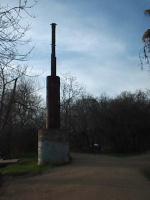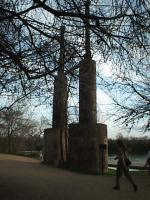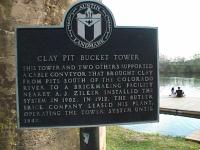Town Lake is a recreational site for people today. But in the past the shores of the Colorado River were the home of industry. One might be hardly able to recognize the shores of the "River City" at the turn of the century.
On the Town Lake hike and bike trail there exists a relic of one of the industries that resided there. In the early 1900's bricks were made from clay mined on the south shore of the Colorado River. The clay pits resided on land that is now part of Zilker Park.
Zilker park is named for Andrew Jackson Zilker, who owned much of the land around Zilker Park, including Barton Springs. It was Zilker who built the conveyor system and owned the land from which the clay was mined. Zilker sold some of his land
around Barton Springs to the city in 1917 for $100,000. In 1932 Zilker donated an additional 300 acres that formed the nucleus of Zilker Park today.

Last remaining sign of the brick industry in Austin
The brickmaking plant that would use the clay resided on the north shore of the Colorado River on a bluff overlooking present day Austin High School. Before Austin had multiple bridges to choose from getting to the opposite bank where the clay resided was a problem. The solution was to create a cable conveyor system over the river, which was done in 1902, if not
before.

Now just a relic in the paths of walkers
To support the cables, three concrete and steel towers were constructed. Buckets attached to the cables carried to clay across the river, but they sometimes carried other payload too. Workers found the buckets a convenient way for them to cross
the river. The system was in operation through 1942 when WWII helped close the brick plant down. Wartime price controls were deemed to make it unprofitable to continue operations so the Butler Brick Company closed it down. If anyone has access to photos or drawings of the towers when they were in operation we'd love to see them.

The historic plaque at the base of the tower
One of those towers remains today, east of MoPac near Austin High School. Located right next door to a rowing house, it includes a plaque providing some history about the structure. Most folks run or bike right by without considering for what purpose it was used.
Austin High's north hill was the scene of a brick dump where broken bricks were disposed of. Apparently a layer of bricks were found 5-6 feet under the ground when planting a memorial oak tree. Currently, we have no indication that any of the brick refuse is visible above ground level.
Sources: History
of Stephen F. Austin High.